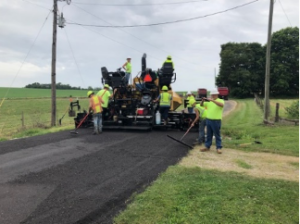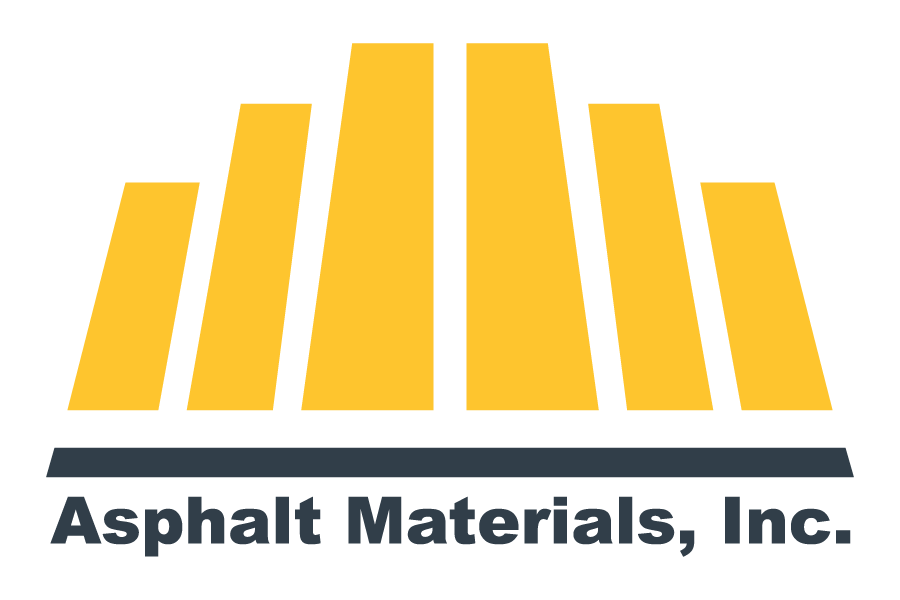Project name: Owen County CCPR Project
In the Spring of 2019, Jason Wielinski and I visited both Montgomery and Owen counties to introduce County Engineer Jim Peck and Supervisor Greg Melton to several recycling processes we thought they might have an interest in, including full depth reclamation (FDR), cold in-place recycling (CIR), and cold central plant recycling (CCPR). County Engineer Peck did indeed have several roads where he was considering an FDR type recycling project, a process he had learned about from a Road School presentation by Jason. Plans were made to continue to work with Jim toward completion of FDR recycling on Airport Road, planning that project for the 2020 season, while adding base material via 2-inch CCAP overlay this season. Since then, a second project has been suggested by the county, a federal aid (FA) FDR project requiring early cost estimates for inclusion in the 2020 FA call for projects.
The mix design called for a 1-inch top size RAP material. Milestone (MLP) agreed to move in and crush the material prior to mixing. They moved in with their crusher, loader, and radial stacker and crushed the 7,000 tons to 1-inch minus in about a week.
The mix design called for a blend ration of 7 gal/ton of mix. At this low rate, a tanker of liquid will produce about 800 tons of mix. The general rule of thumb when doing a CCPR project is that the material should meet the road within 1 hour of being mixed with the liquid, so the mixing and paving operation must be synchronized closely. The number of trucks hauling to the paver was critical; too many trucks resulted in congestion near the paver, too few trucks resulted in the paver waiting for material and the pugmill waiting for a truck to put it in. In either case, production and construction are compromised. To solve this, the truck count was optimized by accurately measuring the time each truck was “at”, and “away” from, the paver. Time “away” included the return from job to mixing plant, loading at the plant, and travel back to the paver. Time “at” was the time any single truck was tailgate to paver, including time backing up and pulling away from the paver. When a full width paver is used on narrow county roads with few intersections, backing to and pulling away from the paver can be considerable. A formula was developed that optimized the truck count for the conditions and location of the jobsite and production was improved and congestion at the paver was reduced

MLP crushing RAP material prior to mixing. Radial stacker was key to a reduction in labor and equipment.
From the early discussions with Supervisor Melton, we knew that chip sealing the finished surface was not an option. (He had a decent distributer but no chip spreader.) Using an overlay defeated the purpose of using the rap. The only alternative remaining to put a skin on the surface was RPE (rapid penetration emulsion). Jason and I were nervous about a CCPR project, with only RPE as the protective cover. We proceeded with the work regardless of that concern, knowing that it could expand the use and capabilities of this relatively new product. Ring testing showed that the very lean RAP material could easily absorb traditional shot rates of RPE, up to 0.20 gsy. In the end, the road was shot twice at a rate of 0.20 gsy each time. The road looked great before and after the RPE application, showing very little to no raveling, and barely distinguishable from HMA sections that connected to it.
After the first 7,000 tons were crushed, mixed, and laid, the county was so satisfied with the cost and performance of the material that they immediately started purchasing more millings. The second phase of the work, nearly a complete repeat of the first, with an additional 5,000 tons of material, is currently underway.
Although this has been, and continues to be, a very successful project, it has not always been easy. After the material was crushed and we were ready to start mixing and paving, the project road had a significant slide develop that required complete closure of the road. The paving plan had to be split in phases, one on each side of the closure. A few days after paving began, the county was hit by two tornados that caused a delay of several days as the county forces had to be redirected to storm damage repair and cleanup. The county’s (brand new) CAT AP555F paver also suffered the usual “out of the box” issues, causing a two-week delay for replacement parts to be delivered. When work restarted, it was discovered that the mixing chamber had not been completely cleared when the paver broke down. The paddles had “tunneled” through some material that had set up in the box, giving the impression that it was clear. The mixing restart caused a jam in the chamber before any material even hit the ground. The next five hours were the longest and hottest hours of the summer for everyone working to clear out the box. The material was finally cleared out with the help of a fire truck cleaning the chamber with high volume, high pressure stream of water. Conversations with MLP led to the purchase of a soybean-based biofuel and a storage/delivery system to clean out the mixing chamber daily. The problem did not occur again after that feature was added to the plant.
Transition from HMA to CCPR pavement sections. Not a pretty transition, but away from the joint, surfaces are comparable.
The aspect of the project that makes it worth writing about is the “One Heritage” attitude that was exhibited by all of the HC&M companies involved. Selling the project to the county was a success of HRG and AMI Sales. The liquid was formulated, and a mix design provided by HRG engineers and technicians. AMI Special Products group staff was on the job in the early stages to oversee and consult with the county forces as issues were encountered and resolved. MLP made their crusher available to turn the RAP into a material that we could work with. The CCPR liquid was produced by Emulsicoat/Urbana and delivered by Woodworth and D lines Trucking.
Finally, the county forces charged with laying the material did an amazing job, with little experience, a new paver, and working on roads in remote locations. There is no shortage of overhanging tree limbs, steep hills, and sharp curves in Owen County.
The county plans to do more of this type of work in the coming years.

Owen County full width paving with CCPR rap mix.



